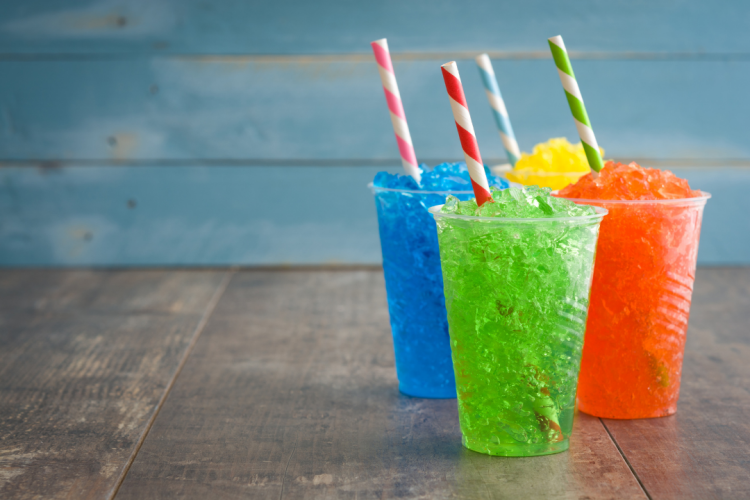Check the ingredients list of slush ice products and concentrate for the items below. If they're included, the product is not suitable for children aged 4 and below.
- Glycerine
- Glycerol
- Additive number E422
The advice on this page applies to ready made slush drinks as well as kits bought to make them at home.

Slush ice drinks, or 'slushies', can contain the ingredient glycerol as a substitute for sugar at a level required to create the ‘slush’ effect. At this level, we recommend that children four years of age and under should not consume these drinks. This is due to their potential to cause side-effects such as headaches and sickness, particularly when consumed in excess.
Glycerol (E 422)
Glycerol (E 422) is authorised as a food additive in accordance with Annex II of Regulation (EC) 1333/2008 on food additives.
View the updated FSA guidance on glycerol.
It is permitted for use at quantum satis in flavoured drinks. Quantum satis means no maximum numerical level is specified and substances must be used in accordance with good manufacturing practice, at a level not higher than is necessary to achieve the intended purpose and provided the consumer is not misled.
Glycerol (E 422) is a key ingredient used in the production of slush ice drinks, having the function of maintaining the slush properties to prevent the liquid freezing solid. However there have been cases of children becoming unwell following excessive consumption. FSS and the FSA has been working with industry on voluntary guidance to protect vulnerable consumers and has agreed the four principles listed below. These are not a legal requirement but are considered best practice.
Industry guidelines for glycerol in slush ice drinks
- Brand owners will ensure that their customers are fully aware of the FSA’s risk assessment of the use of glycerol in slush ice drinks.
- Brand owners will formulate products to contain glycerol at the minimum quantity technically necessary to achieve the required ‘slush’ drink effect.
- Brand owners will advise their customers that sales of slush ice drinks containing glycerol should be accompanied by a written warning visible at point of sale that 'Product contains glycerol. Not recommended for children 4 years of age and under'.
- The business model of free refills is not recommended in venues where children under the age of 10 years will consume them.
Five facts about glycerol and slush ice drinks for parents
The above industry guidelines are based on a worst-case scenario of a slush ice drink containing the top level of 50,000 mg/L glycerol as potential exposure. If in the future, collectively, industry decide to drop the glycerol levels, these guidelines can be reassessed.
Is it safe for my child to drink slush ice drinks?
Those above the age of four are considered unlikely to suffer ill effects from drinking one slush drink. This is because the effects of glycerol are related to body weight.
What does FSS advise about children consuming glycerol slush ice drinks?
To prevent young children being exposed to excessive amounts of glycerol, FSS is advising that:
- slush ice drinks should not be sold to children four years of age and under
- free refill promotions should not be offered to under-10s
What are the symptoms of glycerol intoxication?
At very high levels of exposure – typically when several of these products are drunk by a child in a short space of time – glycerol intoxication could cause shock, hypoglycaemia (low blood sugar) and loss of consciousness.
What is glycerol?
Glycerol (E422) is a key ingredient used in the production of slush ice drinks. It has the function of maintaining the slush properties to prevent the liquid freezing solid.
Although glycerol is generally of low toxicity, there are concerns about the effect on young children when large quantities are consumed over a short period of time.
How does FSS make sure food additives are safe?
Additives must be assessed for safety before they can be used in food.
We also make sure that:
- the science on additives is strictly reviewed
- the law is strictly enforced
- action is taken where problems are found
We investigate any information that casts reasonable doubt on the safety of an additive.